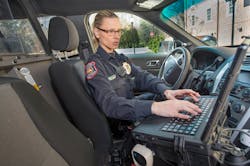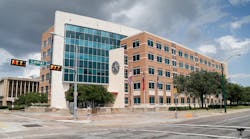Campus police agencies have many of the same needs for effective response to incidents as those of their neighboring municipal police departments, however, they also have special state and federal requirements for reporting crimes and incidents occurring on campus that make their records management system (RMS) needs more specialized. When it comes to keeping records of incidents and calls for service, many college and university police departments have gone electronic.
An electronic RMS has been proven to help school-affiliated agencies minimize costs, become more efficient in investigations, update student rosters, aid in transparency and much more—all while allowing them to prioritize campus safety.
Allow investigators to move faster
The Alamo Colleges Police Department provides safety and security for about 100,000 students and 5,300 faculty and staff for the Alamo Colleges District, a huge network of five community colleges in San Antonio and Universal City, Texas. The school used a manual RMS until 2007, then switched to an electronic system provided by Santa Barbara, Calif.-based Crimestar Corporation, which integrates multiple reporting processes, captures and stores details on a variety of law enforcement documents including accident reports, citations, field interviews, incident/crime reports, sex and narcotics registrants, warrants and firearms registration. With this RMS program, Alamo Colleges has minimized the cost of manpower, paper, ink and other issues.
According to Alamo Colleges Police Chief Don Adams, one of the big problems before automating his RMS was creating and sharing crime reports. “There was such a delay in getting crime reports throughout our prior manual system and into the hands of our investigators,” Adams says. Sometimes, windows of opportunity to deal with suspects or witnesses, or an incident scene, are crucial. The manual RMS that Alamo Colleges once used was slow and paper-based, which caused delays. With the automated RMS, as soon as the officer enters his or her report, “The investigator can pull it up on his computer, read the report, get key information, and move forward—almost the same day,” Adams says.
Alamo Colleges has also seen efficiencies with other features of the RMS, too. Crime and incident reports on college campuses are public information, and colleges tend to get requests routinely from the public to see these reports. With Alamo College’s RMS, if there’s a problem with a report, the RMS has a kickback message feature that alerts the supervisor. But the supervisor does not physically have to be there with the officer to look at his report. Instead, he can send messages to that officer to make corrections.
Public log a vital module
RMS is just as important for small colleges as it is for large ones. Davidson College in Davidson, N.C. has a student population of just below 2,000 and about 500 staff members and has benefited from an electronic RMS. The campus police department is using the Report Exec RMS from Wisconsin-based Competitive Edge Inc., which has about 25 different modules in addition to CAD and mobile app capabilities. A key feature, which is required for any school campus, is the ability to create a public log of campus incident and crime activities. “We use the public log feature daily because we have to update our log within two business days,” says Davidson College Chief Todd Sigler. “We can accomplish this update online by uploading the public log within Report Exec to our webpage.” Sigler notes that the public log offering is just part of the RMS reporting capabilities. “We add in this public log more than we’re required,” Sigler says.
Davidson College has integrated software from Maxient with Report Exec, which expressly helps schools comply with regulatory requirements like the Clery Act. The software offers proactive alerts when an incident occurs and requires Davidson College PD’s involvement, and has both built-in reports and custom report writing capability. “It’s all about transparency and sharing as much information as you can with the public,” Sigler says. “Even our campus newspaper picks up the public log and publishes it once a week.”
The new RMS also allows Davidson College PD to update the college’s student roster, a feature not available on older versions used by the department. “When I begin to enter information about a student on campus, the RMS will pull additional information about [them] from another existing database and populate the RMS record so that I don’t have to type in all of that information,” Sigler explains. “That’s really the beauty of any records management system—cutting down on the redundancy.”
The software has also helped Alamo College narrow down suspects of a crime with the help of cross-referencing. In one instance at Alamo College a building had been broken into. Using its electronic RMS, the college was able to develop a suspect because he had been entered into the software on another case. “We got the guy on videotape,” Adams recalls, “and plugged some information into the RMS and got some suspects. We eliminated every suspect except this one guy based just on physical appearance. In the past, with our paper-based records system, we would never have been able to do this,” he adds.
The RMS used by Alamo Colleges also offers a citations module as standard in the software. The college has substations at each of its five campuses and a clerk in each one. “This person has access to Crimestar because he takes care of all our campus tickets and Justice of Peace citations using the module,” Adams says. The citation module, which captures and indexes information typically found on a traffic citation or parking violation, is linked to the RMS Master Vehicle Index. Citation data can also be used to create a “ticket” that can be issued to a violator.
While colleges and universities are the predominant users of RMS programs, many districts that encompass high schools and lower grade levels also gain from the benefits. Such is the case for the Austin Independent School District (AISD), a sprawling network of elementary, middle and high schools that covers the Austin, Texas, metroplex.
CAD tied to RMS
AISD has used its RMS from Crimestar since 2005 and is integrated with the software’s CAD program. “Having our RMS linked to our CAD definitely helps with response time because the schools don’t have to call 911, then have 911 call us to dispatch officers to a location for an incident,“ said Pamela Waugh, police services specialist for the AISD.
Agencies reliant upon a CAD system not integrated with their RMS may not have a lot of critical information populating.
In many instances, a dispatcher will assign an incident case number to the CAD once an officer calls in an incident in progress. However, not all calls for service will receive a case number.
The officer will create his incident in the RMS. Once this step is completed, the CAD information is transferred into that case. As the officer enters information into the incident case pertaining to people or vehicles, if this information is already in the software’s Master Name, Address and Vehicle indexes, the software will show this. The RMS will indicate if there are matches for this information just entered and ask the officer if he wishes to use this information. If there is no match, then the information is added to the Master Name Index automatically. From that point, any criminal involvements a person has—arrest, field interview, citation, etc.—will be added to the Master Name Index.
Waugh says the field interview module has proven particularly helpful and is used frequently by her department. The module can be used by an officer for a trespass warning, for example. “It could be anything requiring the officer to talk to somebody about, and for which we need to have a record of this interview, but which we don’t feel merits having a whole case done on it,” Waugh says. “If, after the criminal trespass warning and the field interview are accomplished and this person comes back to campus, he is arrested for criminal trespass.”
The need for an effective, easy to use and information rich RMS is vital. Above all, a solid, robust RMS should give its campus law enforcement agency the capabilities to help ensure safety for students and staff, to have quick response to incidents and calls for service, and to enable the school to meet its unique regulatory reporting needs.



